Analysis of Effects of Recent Changes in Hydrothermal Conditions on Vegetation in Central Asia
Abstract
:1. Introduction
2. Materials and Methods
2.1. Study Area
2.2. Data
2.2.1. NDVI Dataset Sources
2.2.2. Climate Data Sources
2.3. Methods
2.3.1. Theil–Sen Median Analysis and the Mann–Kendall Trend Test
2.3.2. Correlation Analysis
2.3.3. Boosted Regression Tree Model
3. Results
3.1. Spatiotemporal Patterns of Vegetation Dynamics Trend
3.2. Correlation Analysis between Vegetation Changes and Hydrothermal Conditions
3.2.1. Significance of Correlations between Vegetation and Hydrothermal Conditions
3.2.2. Superposition Analysis of Correlations between Hydrothermal Conditions and Vegetation
- (1).
- Hydrothermal tradeoff effect (water) (TEW) (rpre > 0 or rsm > 0 and rtmp ≤ 0 or rpet ≤ 0 and ptep ≤ 0.05, and ppet ≤ 0.05 and ppre ≤ 0.05, and psm ≤ 0.05), that is, heat conditions have an inhibitory effect on vegetation growth, while water conditions have a promoting effect;
- (2).
- Hydrothermal tradeoff effect (heat) (TEH) (rpre < 0 or rsm < 0 and rtmp > 0 or rpet > 0 and ptep ≤ 0.05, and ppet ≤ 0.05 and ppre ≤ 0.05, and psm ≤ 0.05), that is, heat conditions have a promoting effect on vegetation growth, while water conditions have an inhibitory effect;
- (3).
- Hydrothermal synergy effect (positive) (SEP) (rpre > 0 or rsm > 0 and rtmp > 0 or rpet > 0 and ptep ≤ 0.05, and ppet ≤ 0.05 and ppre ≤ 0.05, and psm ≤ 0.05), that is, heat conditions and water conditions have a promoting effect on vegetation growth;
- (4).
- Hydrothermal synergy effect (negative) (SEN) (rpre < 0 or rsm < 0 and rtmp < 0 or rpet < 0 and ptep ≤ 0.05, and ppet ≤ 0.05 and ppre ≤ 0.05, and psm ≤ 0.05), that is, heat conditions and water conditions have an inhibitory effect on vegetation growth.
- (1)
- Positive correlation with water (PW) (rpre > 0 or rsm > 0 and ppre ≤ 0.05, or psm ≤ 0.05 and ptep > 0.05 and ppet > 0.05), that is, water conditions promote vegetation growth, while heat conditions have an insignificant effect on vegetation growth;
- (2)
- Negative correlation with water (NW) (rpre < 0 or rsm < 0 and ppre ≤ 0.05, or psm ≤ 0.05 and ptep > 0.05 and ppet > 0.05), that is, water conditions have an inhibitory effect on vegetation growth, while heat conditions have an insignificant effect on vegetation growth.
- (1)
- Positive correlation with heat (PH) (rtmp > 0 or rpet > 0 and ptep ≤ 0.05, or ppet ≤ 0.05 and ppre > 0.05 and psm > 0.05), that is, heat conditions promote vegetation growth, while water conditions have an insignificant effect on vegetation growth;
- (2)
- Negative correlation with heat (NH) (rtmp < 0 or rpet < 0 and ptep ≤ 0.05, or ppet ≤ 0.05 and ppre > 0.05 and psm > 0.05), that is, heat conditions have an inhibitory effect on vegetation growth, while water conditions have an insignificant effect on vegetation growth.
3.3. Contributions of Hydrothermal Conditions to Vegetation Changes
3.4. Contributions of Hydrothermal Factors to Vegetation Change
4. Discussion
5. Conclusions
Author Contributions
Funding
Institutional Review Board Statement
Informed Consent Statement
Data Availability Statement
Conflicts of Interest
Appendix A

References
- Foley, J.A.; Levis, S.; Costa, M.H.; Cramer, W.; Pollard, D. Incorporating dynamic vegetation cover within global climate models. Ecol. Appl. 2000, 10, 1620–1632. [Google Scholar] [CrossRef]
- Cao, M.; Woodward, F.I. Dynamic responses of terrestrial ecosystem carbon cycling to global climate change. Nature 1998, 393, 249–252. [Google Scholar] [CrossRef]
- Peng, J.; Liu, Z.; Liu, Y.; Wu, J.; Han, Y. Trend analysis of vegetation dynamics in Qinghai–Tibet plateau using hurst exponent. Ecol. Indic. 2012, 14, 28–39. [Google Scholar] [CrossRef]
- Piao, S.; Wang, X.; Ciais, P.; Zhu, B.; Wang, T.; Liu, J. Changes in satellite-derived vegetation growth trend in temperate and boreal Eurasia from 1982 to 2006. Glob. Chang. Biol. 2011, 17, 3228–3239. [Google Scholar] [CrossRef]
- Zhu, S.; Li, C.; Shao, H.; Ju, W.; Lv, N. The response of carbon stocks of drylands in Central Asia to changes of CO2 and climate during past 35 years. Sci. Total Environ. 2019, 687, 330–340. [Google Scholar] [CrossRef] [PubMed]
- Chen, T.; Xia, J.; Zou, L.; Hong, S. Quantifying the Influences of Natural Factors and Human Activities on NDVI Changes in the Hanjiang River Basin, China. Remote Sens. 2020, 12, 3780. [Google Scholar] [CrossRef]
- Peng, S.; Piao, S.; Ciais, P.; Myneni, R.B.; Chen, A.; Chevallier, F.; Dolman, A.J.; Janssens, I.A.; Peñuelas, J.; Zhang, G.; et al. Asymmetric effects of daytime and night-time warming on Northern Hemisphere vegetation. Nature 2013, 501, 88–92. [Google Scholar] [CrossRef]
- Zhu, L.; Meng, J.; Zhu, L. Applying Geodetector to disentangle the contributions of natural and anthropogenic factors to NDVI variations in the middle reaches of the Heihe River Basin. Ecol. Indic. 2020, 117, 106545. [Google Scholar] [CrossRef]
- Vicente-Serrano, S.M.; Gouveia, C.; Camarero, J.J.; Beguería, S.; Trigo, R.; Lopez-Moreno, J.I.; Azorin-Molina, C.; Pasho, E.; Lorenzo-Lacruz, J.; Revuelto, J.; et al. Response of vegetation to drought time-scales across global land biomes. Proc. Natl. Acad. Sci. USA 2013, 110, 52–57. [Google Scholar] [CrossRef] [Green Version]
- Nemani, R.R.; Keeling, C.D.; Hashimoto, H.; Jolly, W.M.; Piper, S.C.; Tucker, C.J.; Myneni, R.B.; Running, S.W. Climate-Driven Increases in Global Terrestrial Net Primary Production from 1982 to 1999. Science 2003, 300, 1560–1563. [Google Scholar] [CrossRef] [Green Version]
- Hasanuzzaman, M.; Nahar, K.; Alam, M.; Roychowdhury, R.; Fujita, M. Physiological, Biochemical, and Molecular Mechanisms of Heat Stress Tolerance in Plants. Int. J. Mol. Sci. 2013, 14, 9643–9684. [Google Scholar] [CrossRef]
- Chai, Q.; Wang, T.; Di, C. Evaluating the impacts of environmental factors on soil moisture temporal dynamics at different time scales. J. Water Clim. Chang. 2021, 12, 420–432. [Google Scholar] [CrossRef]
- Yang, Y.; Wang, S.; Bai, X.; Tan, Q.; Li, Q.; Wu, L.; Tian, S.; Hu, Z.; Li, C.; Deng, Y. Factors Affecting Long-Term Trends in Global NDVI. Forests 2019, 10, 372. [Google Scholar] [CrossRef] [Green Version]
- Dusenge, M.E.; Duarte, A.G.; Way, D.A. Plant carbon metabolism and climate change: Elevated CO2 and temperature impacts on photosynthesis, photorespiration and respiration. New Phytol. 2019, 221, 32–49. [Google Scholar] [CrossRef] [PubMed] [Green Version]
- Myers-Smith, I.H.; Kerby, J.T.; Phoenix, G.K.; Bjerke, J.W.; Epstein, H.E.; Assmann, J.J.; John, C.; Andreu-Hayles, L.; Angers-Blondin, S.; Beck, P.S.A.; et al. Complexity revealed in the greening of the Arctic. Nat. Clim. Chang. 2020, 10, 106–117. [Google Scholar] [CrossRef] [Green Version]
- Zandalinas, S.I.; Mittler, R.; Balfagón, D.; Arbona, V.; Gómez-Cadenas, A. Plant adaptations to the combination of drought and high temperatures. Physiol. Plant. 2018, 162, 2–12. [Google Scholar] [CrossRef] [Green Version]
- Xu, H.-J.; Wang, X.-P.; Yang, T.-B. Trend shifts in satellite-derived vegetation growth in Central Eurasia, 1982–2013. Sci. Total Environ. 2017, 579, 1658–1674. [Google Scholar] [CrossRef]
- Luo, N.; Mao, D.; Wen, B.; Liu, X. Climate Change Affected Vegetation Dynamics in the Northern Xinjiang of China: Evaluation by SPEI and NDVI. Land 2020, 9, 90. [Google Scholar] [CrossRef] [Green Version]
- Piao, S.; Nan, H.; Huntingford, C.; Ciais, P.; Friedlingstein, P.; Sitch, S.; Peng, S.; Ahlström, A.; Canadell, J.G.; Cong, N.; et al. Evidence for a weakening relationship between interannual temperature variability and northern vegetation activity. Nat. Commun. 2014, 5, 5018. [Google Scholar] [CrossRef] [Green Version]
- Saseendran, S.; Trout, T.; Ahuja, L.; Ma, L.; McMaster, G.; Nielsen, D.; Andales, A.; Chávez, J.; Ham, J. Quantifying crop water stress factors from soil water measurements in a limited irrigation experiment. Agric. Syst. 2015, 137, 191–205. [Google Scholar] [CrossRef]
- Tai, X.; Epstein, H.E.; Li, B. Elevation and Climate Effects on Vegetation Greenness in an Arid Mountain-Basin System of Central Asia. Remote Sens. 2020, 12, 1665. [Google Scholar] [CrossRef]
- Wang, H.; Li, Z.; Cao, L.; Feng, R.; Pan, Y. Response of NDVI of Natural Vegetation to Climate Changes and Drought in China. Land 2021, 10, 966. [Google Scholar] [CrossRef]
- Wang, H.; Liu, X.; Zhang, X.; Wang, P.; Lin, H.; Yu, L. Spatiotemporal crop NDVI responses to climatic factors in mainland China. Int. J. Remote Sens. 2019, 40, 89–103. [Google Scholar] [CrossRef]
- Bai, J.; Shi, H.; Yu, Q.; Xie, Z.; Li, L.; Luo, G.; Jin, N.; Li, J. Satellite-observed vegetation stability in response to changes in climate and total water storage in Central Asia. Sci. Total Environ. 2019, 659, 862–871. [Google Scholar] [CrossRef]
- De Jong, R.; De Bruin, S.; de Wit, A.; Schaepman, M.; Dent, D.L. Analysis of monotonic greening and browning trends from global NDVI time-series. Remote Sens. Environ. 2011, 115, 692–702. [Google Scholar] [CrossRef] [Green Version]
- Tucker, C.J.; Pinzon, J.E.; Brown, M.E.; Slayback, D.A.; Pak, E.W.; Mahoney, R.; Vermote, E.F.; El Saleous, N. An extended AVHRR 8-km NDVI dataset compatible with MODIS and SPOT vegetation NDVI data. Int. J. Remote Sens. 2005, 26, 4485–4498. [Google Scholar] [CrossRef]
- Zhu, Z.; Piao, S.; Myneni, R.B.; Huang, M.; Zeng, Z.; Canadell, J.G.; Ciais, P.; Sitch, S.; Friedlingstein, P.; Arneth, A.; et al. Greening of the Earth and its drivers. Nat. Clim. Chang. 2016, 6, 791–795. [Google Scholar] [CrossRef]
- Davi, N.; D’Arrigo, R.; Jacoby, G.; Cook, E.; Anchukaitis, K.; Nachin, B.; Rao, M.; Leland, C. A long-term context (931–2005 C.E.) for rapid warming over Central Asia. Quat. Sci. Rev. 2015, 121, 89–97. [Google Scholar] [CrossRef] [Green Version]
- Hu, Z.; Zhang, C.; Hu, Q.; Tian, H. Temperature Changes in Central Asia from 1979 to 2011 Based on Multiple Datasets. J. Clim. 2014, 27, 1143–1167. [Google Scholar] [CrossRef]
- Li, Z.; Chen, Y.; Li, W.; Deng, H.; Fang, G. Potential impacts of climate change on vegetation dynamics in Central Asia. J. Geophys. Res. Atmos. 2015, 120, 12345–12356. [Google Scholar] [CrossRef]
- Mannig, B.; Müller, M.; Starke, E.; Merkenschlager, C.; Mao, W.; Zhi, X.; Podzun, R.; Jacob, D.; Paeth, H. Dynamical downscaling of climate change in Central Asia. Glob. Planet. Chang. 2013, 110, 26–39. [Google Scholar] [CrossRef]
- Guo, H.; Bao, A.; Ndayisaba, F.; Liu, T.; Jiapaer, G.; El-Tantawi, A.M.; De Maeyer, P. Space-time characterization of drought events and their impacts on vegetation in Central Asia. J. Hydrol. 2018, 564, 1165–1178. [Google Scholar] [CrossRef]
- Liu, Y.; Li, L.; Chen, X.; Zhang, R.; Yang, J. Temporal-spatial variations and influencing factors of vegetation cover in Xinjiang from 1982 to 2013 based on GIMMS-NDVI3g. Glob. Planet. Chang. 2018, 169, 145–155. [Google Scholar] [CrossRef]
- Xu, H.-J.; Wang, X.-P.; Zhang, X.-X. Decreased vegetation growth in response to summer drought in Central Asia from 2000 to 2012. Int. J. Appl. Earth Obs. Geoinf. 2016, 52, 390–402. [Google Scholar] [CrossRef]
- Deng, H.; Yin, Y.; Han, X. Vulnerability of vegetation activities to drought in Central Asia. Environ. Res. Lett. 2020, 15, 084005. [Google Scholar] [CrossRef]
- Yin, G.; Hu, Z.; Chen, X.; Tiyip, T. Vegetation dynamics and its response to climate change in Central Asia. J. Arid Land 2016, 8, 375–388. [Google Scholar] [CrossRef] [Green Version]
- Jiang, L.; Guli·jiapaer, G.; Bao, A.; Guo, H.; Ndayisaba, F. Vegetation dynamics and responses to climate change and human activities in Central Asia. Sci. Total Environ. 2017, 599–600, 967–980. [Google Scholar] [CrossRef]
- De Beurs, K.M.; Henebry, G.M.; Owsley, B.C.; Sokolik, I. Using multiple remote sensing perspectives to identify and attribute land surface dynamics in Central Asia 2001–2013. Remote Sens. Environ. 2015, 170, 48–61. [Google Scholar] [CrossRef]
- Wang, W.; Alim, S.; Jilili, A. Geo-detector based spatio-temporal variation characteristics and driving factors analysis of NDVI in Central Asia. Remote Sens. Land Resour. 2019, 31, 32–40. [Google Scholar]
- Dong, W.; Lin, Y.; Wright, J.S.; Xie, Y.; Ming, Y.; Zhang, H.; Chen, R.; Chen, Y.; Xu, F.; Lin, N.; et al. Regional disparities in warm season rainfall changes over arid eastern–central Asia. Sci. Rep. 2018, 8, 13051. [Google Scholar] [CrossRef]
- Klein, I.; Gessner, U.; Kuenzer, C. Regional land cover mapping and change detection in Central Asia using MODIS time-series. Appl. Geogr. 2012, 35, 219–234. [Google Scholar] [CrossRef]
- Mohammat, A.; Wang, X.; Xu, X.; Peng, L.; Yang, Y.; Zhang, X.; Myneni, R.; Piao, S. Drought and spring cooling induced recent decrease in vegetation growth in Inner Asia. Agric. For. Meteorol. 2013, 178–179, 21–30. [Google Scholar] [CrossRef]
- Jiang, W.; Yuan, L.; Wang, W.; Cao, R.; Zhang, Y.; Shen, W. Spatio-temporal analysis of vegetation variation in the Yellow River Basin. Ecol. Indic. 2015, 51, 117–126. [Google Scholar] [CrossRef]
- Liu, Y.; Li, Y.; Li, S.C.; Motesharrei, S.C. Spatial and Temporal Patterns of Global NDVI Trends: Correlations with Climate and Human Factors. Remote Sens. 2015, 7, 13233–13250. [Google Scholar] [CrossRef] [Green Version]
- Tucker, C.J.; Townshend, J.R.; Goff, T.E. African Land-Cover Classification Using Satellite Data. Science 1985, 227, 369–375. [Google Scholar] [CrossRef] [PubMed]
- Chen, C.; Qian, J.; Chen, X.; Hu, Z.; Sun, J.; Wei, S.; Xu, K. Geographic Distribution of Desert Locusts in Africa, Asia and Europe Using Multiple Sources of Remote-Sensing Data. Remote Sens. 2020, 12, 3593. [Google Scholar] [CrossRef]
- Ashby, J.; Moreno-Madriñán, M.J.; Yiannoutsos, C.T.; Stanforth, A. Niche Modeling of Dengue Fever Using Remotely Sensed Environmental Factors and Boosted Regression Trees. Remote Sens. 2017, 9, 328. [Google Scholar] [CrossRef] [Green Version]
- Elith, J.; Leathwick, J.R.; Hastie, T. A working guide to boosted regression trees. J. Anim. Ecol. 2008, 77, 802–813. [Google Scholar] [CrossRef]
- Prasad, A.M.; Iverson, L.R.; Liaw, A. Newer Classification and Regression Tree Techniques: Bagging and Random Forests for Ecological Prediction. Ecosystems 2006, 9, 181–199. [Google Scholar] [CrossRef]
- De’Ath, G. Boosted trees for ecological modeling and prediction. Ecology 2007, 88, 243–251. [Google Scholar] [CrossRef]
- Liu, Z.; Yang, J.-G.; Ma, L.-H.; Ke, Z.-M.; Hu, Y.-M.; Yan, X.-Y. Spatial-temporal trend of grassland net primary production and their driving factors in the Loess Plateau, China. Ying Yong Sheng Tai Xue Bao = J. Appl. Ecol. 2021, 32, 113–122. [Google Scholar]
- Nezlin, N.; Kostianoy, A.; Li, B.-L. Inter-annual variability and interaction of remote-sensed vegetation index and atmospheric precipitation in the Aral Sea region. J. Arid Environ. 2005, 62, 677–700. [Google Scholar] [CrossRef]
- Propastin, P.A.; Kappas, M.; Muratova, N.R. Inter-Annual Changes in Vegetation Activities and Their Relationship to Temperature and Precipitation in Central Asia from 1982 to 2003. J. Environ. Inform. 2008, 12, 75–87. [Google Scholar] [CrossRef] [Green Version]
- Sun, W.; Song, X.; Mu, X.; Gao, P.; Wang, F.; Zhao, G. Spatiotemporal vegetation cover variations associated with climate change and ecological restoration in the Loess Plateau. Agric. For. Meteorol. 2015, 209–210, 87–99. [Google Scholar] [CrossRef]
- Chu, H.; Venevsky, S.; Wu, C.; Wang, M. NDVI-based vegetation dynamics and its response to climate changes at Amur-Heilongjiang River Basin from 1982 to 2015. Sci. Total Environ. 2019, 650, 2051–2062. [Google Scholar] [CrossRef] [PubMed]
- Hu, T.; Li, X.; Gong, P.; Yu, W.; Huang, X. Evaluating the effect of plain afforestation project and future spatial suitability in Beijing. Sci. China Earth Sci. 2020, 63, 1587–1598. [Google Scholar] [CrossRef]
- Zhou, L.M.; Tucker, C.J.; Kaufmann, R.K.; Slayback, D.; Shabanov, N.V.; Myneni, R.B. Variations in northern vegetation activity inferred from satellite data of vegetation index during 1981 to 1999. J. Geophys. Res.-Atmos. 2001, 106, 20069–20083. [Google Scholar] [CrossRef]
- Luo, M.; Sa, C.; Meng, F.; Duan, Y.; Liu, T.; Bao, Y. Assessing extreme climatic changes on a monthly scale and their implications for vegetation in Central Asia. J. Clean. Prod. 2020, 271, 122396. [Google Scholar] [CrossRef]
- Gessner, U.; Naeimi, V.; Klein, I.; Kuenzer, C.; Klein, D.; Dech, S. The relationship between precipitation anomalies and satellite-derived vegetation activity in Central Asia. Glob. Planet. Chang. 2013, 110, 74–87. [Google Scholar] [CrossRef]
- Dubovyk, O.; Landmann, T.; Dietz, A.; Menz, G. Quantifying the Impacts of Environmental Factors on Vegetation Dynamics over Climatic and Management Gradients of Central Asia. Remote Sens. 2016, 8, 600. [Google Scholar] [CrossRef] [Green Version]
- Lioubimtseva, E. A multi-scale assessment of human vulnerability to climate change in the Aral Sea basin. Environ. Earth Sci. 2015, 73, 719–729. [Google Scholar] [CrossRef]
- Mueller, T.; Dressler, G.; Tucker, C.J.; Pinzon, J.E.; Leimgruber, P.; Dubayah, R.O.; Hurtt, G.C.; Böhning-Gaese, K.; Fagan, W.F. Human Land-Use Practices Lead to Global Long-Term Increases in Photosynthetic Capacity. Remote Sens. 2014, 6, 5717–5731. [Google Scholar] [CrossRef] [Green Version]



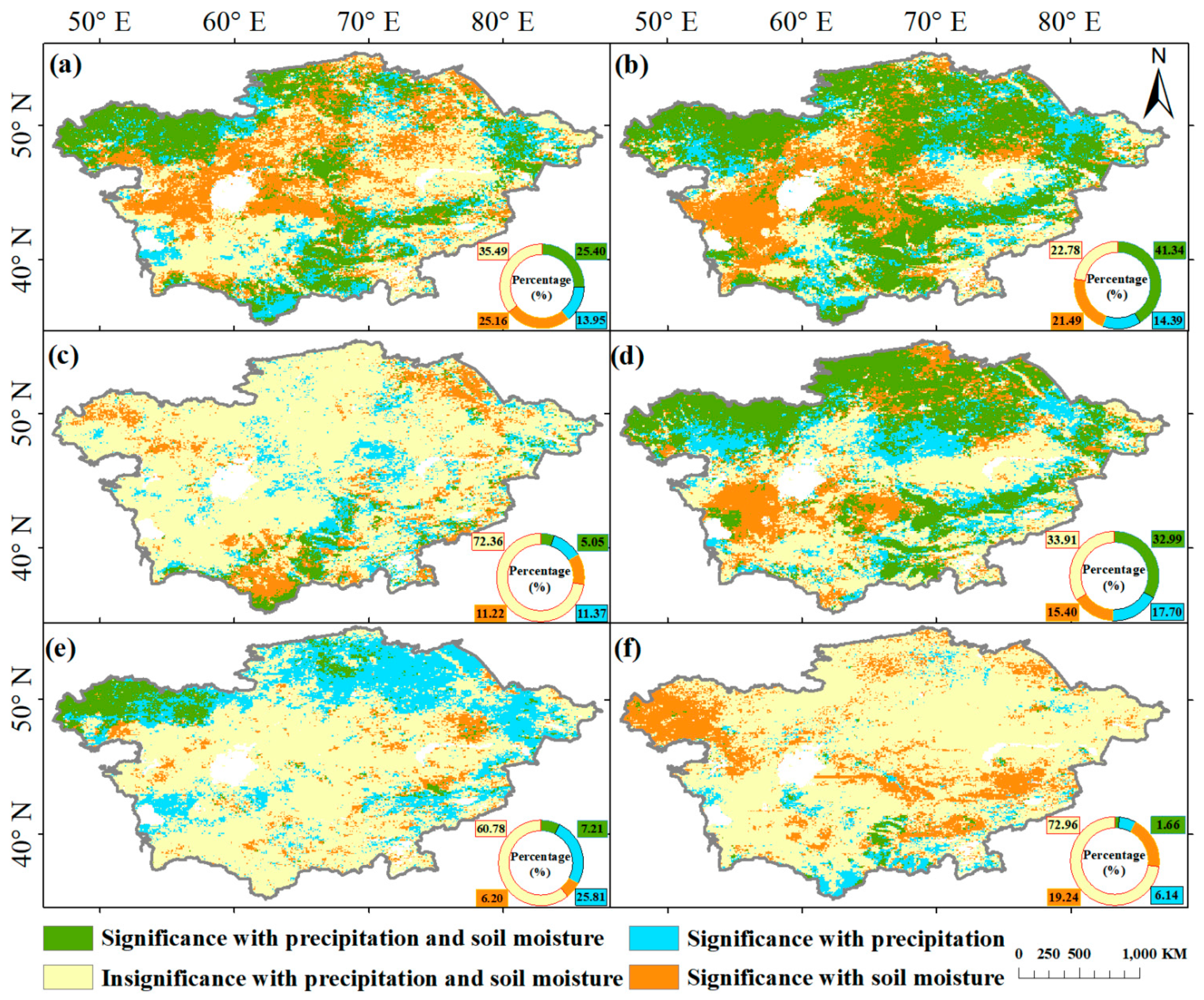
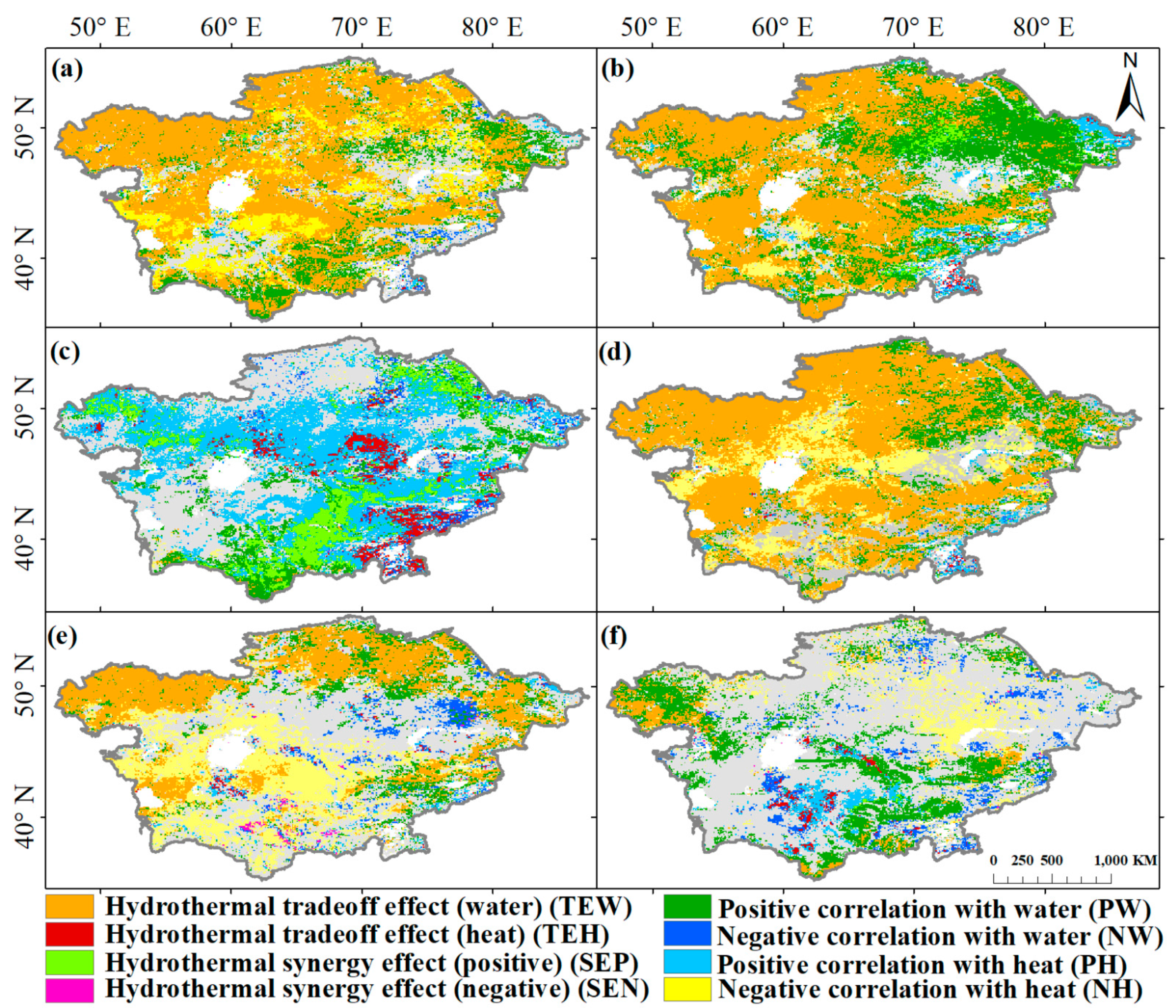
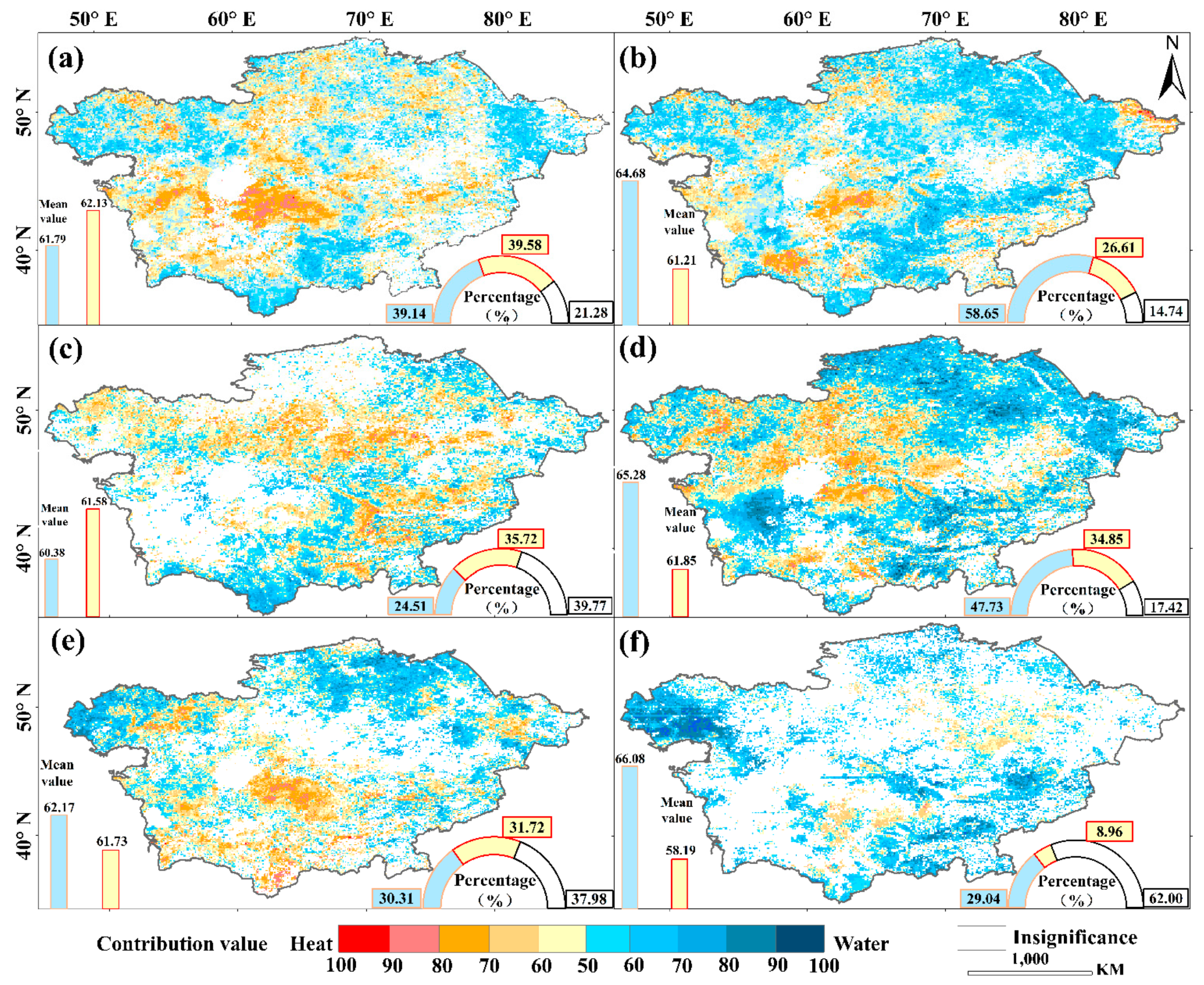
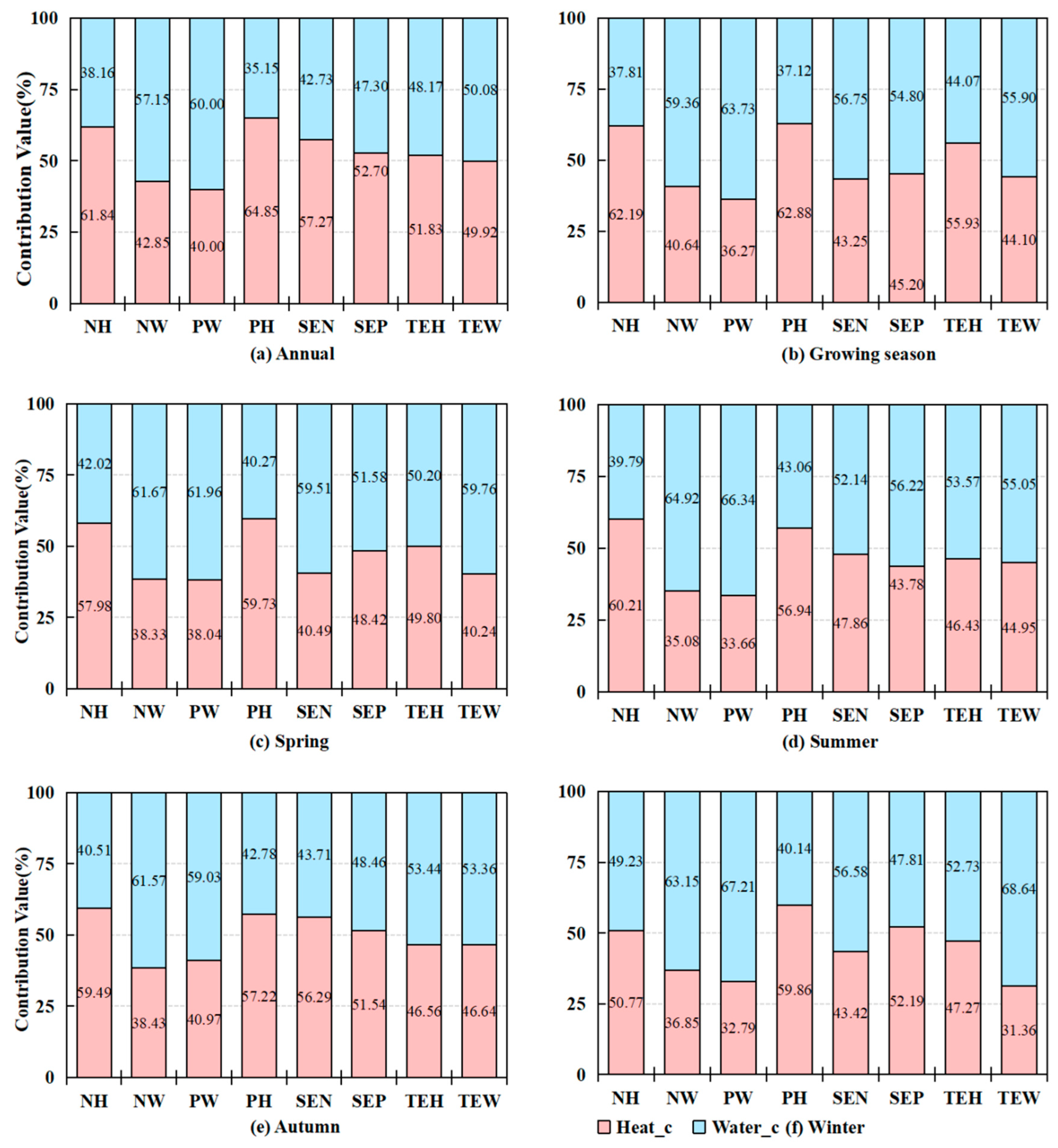
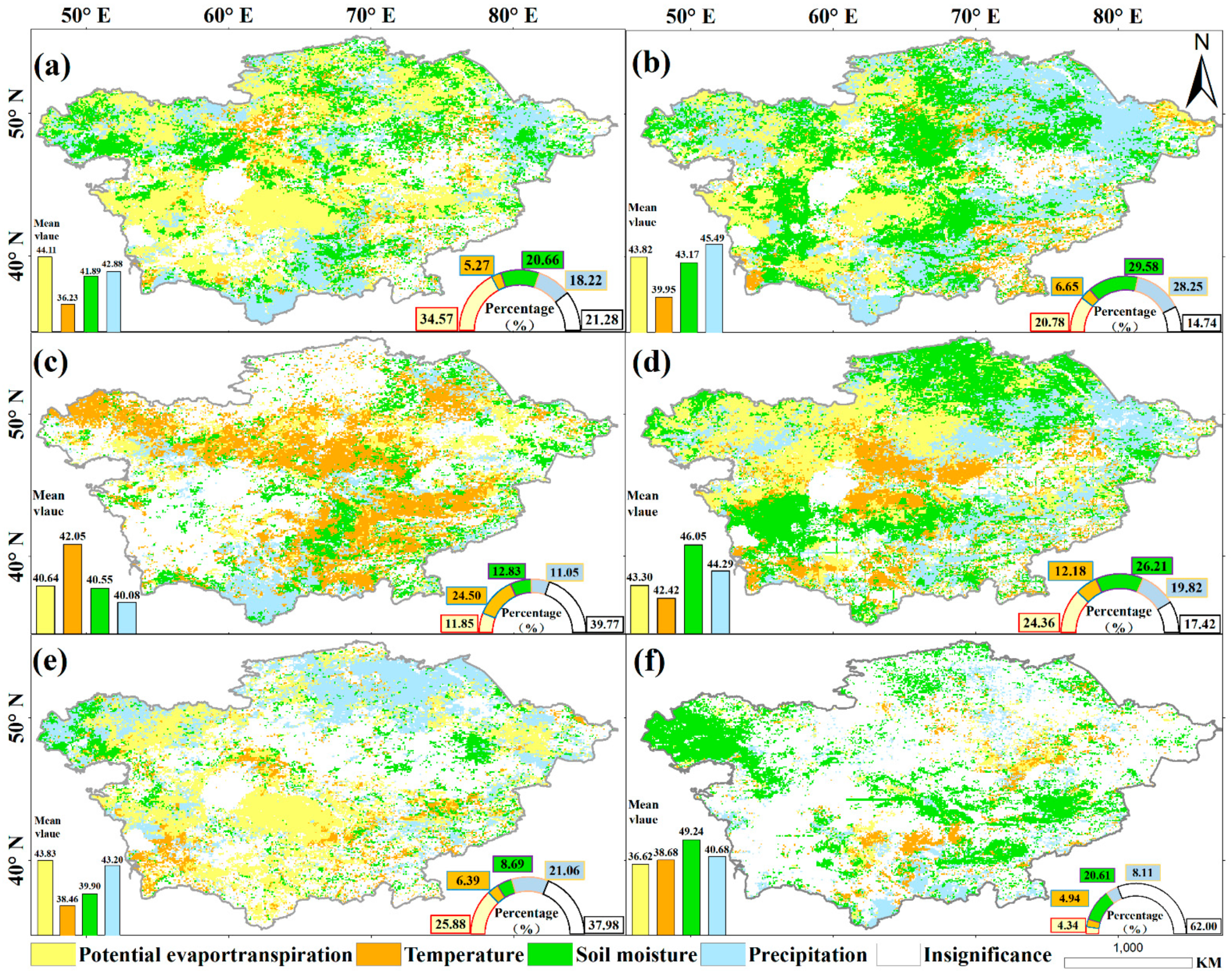

| Dataset | Spatial Resolution | Temporal Resolution |
|---|---|---|
| GIMMS NDVI | 0.083° | 15 days |
| Precipitation | 0.5° | month |
| Soil moisture | 0.25° | month |
| PET | 0.5° | month |
| Temperature | 0.5° | month |
| SNDVI | Z | NDVItrend |
|---|---|---|
| >0 | ≥1.96 or ≤−1.96 | Significant improvement |
| >0 | −1.96~1.96 | Slight improvement |
| 0 | ≥1.96 or ≤−1.96 or −1.96~1.96 | Stable or non-vegetated |
| <0 | −1.96~1.96 | Slight degradation |
| <0 | ≥1.96 or ≤−1.96 | Severe degradation |
| Classifications | Conditions | Contribution Direction | |
|---|---|---|---|
| Thermal Conditions | Water Conditions | ||
| Hydrothermal tradeoff effect (water)(TEW) | rpre > 0 or rsm > 0 and rtmp ≤ 0 or rpet ≤ 0 and ptem ≤ 0.05 and ppet ≤ 0.05 and ppre ≤ 0.05 and psm ≤ 0.05 | negative | positive |
| Hydrothermal tradeoff effect (heat)(TEH) | rpre < 0 or rsm < 0 and rtmp > 0 or rpet > 0 and ptem ≤ 0.05 and ppet ≤ 0.05 and ppre ≤ 0.05 and psm ≤ 0.05 | positive | negative |
| Hydrothermal synergy effect (positive)(SEP) | rpre > 0 or rsm > 0 and rtmp > 0 or rpet > 0 and ptem ≤ 0.05 and ppet ≤ 0.05 and ppre ≤ 0.05 and psm ≤ 0.05 | positive | positive |
| Hydrothermal synergy effect (negative)(SEN) | rpre < 0 or rsm < 0 and rtmp < 0 or rpet < 0 and ptem ≤ 0.05 and ppet ≤ 0.05 and ppre ≤ 0.05 and psm ≤ 0.05 | negative | negative |
| Positive correlation with water(PW) | rpre > 0 or rsm > 0 and ppre ≤ 0.05 or psm ≤ 0.05 and ptem > 0.05 and ppet > 0.05 | insignificance | positive |
| Negative correlation with water(NW) | rpre < 0 or rsm < 0 and ppre ≤ 0.05 or psm ≤ 0.05 and ptem > 0.05 and ppet > 0.05 | insignificance | negative |
| Positive correlation with heat(PH) | rtmp > 0 or rpet > 0 and ptem ≤ 0.05 or ppet ≤ 0.05 and ppre > 0.05 and psm > 0.05 | positive | insignificance |
| Negative correlation with heat(NH) | rtmp < 0 or rpet < 0 and ptem ≤ 0.05 or ppet ≤ 0.05 and ppre > 0.05 and psm > 0.05 | negative | insignificance |
| Insignificance | ptem > 0.05 and ppet > 0.05 and ppre > 0.05 and psm > 0.05 | insignificance | insignificance |
| Time Scales | TEW | TEH | SEP | SEN | PW | NW | PH | NH | Insignificance |
|---|---|---|---|---|---|---|---|---|---|
| Annual | 49.06 | 0.19 | 0.08 | 0.05 | 14.16 | 0.97 | 0.62 | 13.60 | 21.28 |
| Growing season | 46.17 | 0.57 | 2.52 | 0.04 | 27.63 | 0.27 | 3.64 | 4.40 | 14.74 |
| Spring | 0.27 | 5.04 | 10.80 | 0.06 | 7.74 | 3.72 | 32.11 | 0.49 | 39.77 |
| Summer | 52.53 | 0.32 | 0.11 | 0.03 | 12.74 | 0.35 | 1.30 | 15.20 | 17.42 |
| Autumn | 24.95 | 0.56 | 0.05 | 0.48 | 9.78 | 3.39 | 1.30 | 21.52 | 37.98 |
| Winter | 4.27 | 1.19 | 0.20 | 0.14 | 16.01 | 5.23 | 2.84 | 8.12 | 62.00 |
| Regions | Annual | Growing Season | Spring | Summer | Autumn | Winter |
|---|---|---|---|---|---|---|
| NH | −0.48 | −0.77 | −0.80 | −0.90 | −0.99 | −1.17 |
| PH | 0.98 | 1.39 | 0.70 | 1.82 | 1.39 | −0.13 |
| NW | 0.81 | −0.09 | 0.62 | −0.10 | 0.02 | −0.19 |
| PW | 0.24 | 0.71 | 0.48 | 0.90 | −0.05 | −1.29 |
| SEN | −0.64 | −2.55 | −1.65 | −2.70 | −0.68 | −0.94 |
| SEP | 0.004 | 1.71 | 0.97 | 3.21 | 1.91 | −0.59 |
| TEH | 1.29 | 0.96 | 1.10 | 1.10 | 1.01 | 0.08 |
| TEW | −0.66 | −0.52 | −0.51 | −0.58 | −0.88 | −1.57 |
Publisher’s Note: MDPI stays neutral with regard to jurisdictional claims in published maps and institutional affiliations. |
© 2022 by the authors. Licensee MDPI, Basel, Switzerland. This article is an open access article distributed under the terms and conditions of the Creative Commons Attribution (CC BY) license (https://creativecommons.org/licenses/by/4.0/).
Share and Cite
Xing, X.; Qian, J.; Chen, X.; Chen, C.; Sun, J.; Wei, S.; Yimamaidi, D.; Zhanar, Z. Analysis of Effects of Recent Changes in Hydrothermal Conditions on Vegetation in Central Asia. Land 2022, 11, 327. https://doi.org/10.3390/land11030327
Xing X, Qian J, Chen X, Chen C, Sun J, Wei S, Yimamaidi D, Zhanar Z. Analysis of Effects of Recent Changes in Hydrothermal Conditions on Vegetation in Central Asia. Land. 2022; 11(3):327. https://doi.org/10.3390/land11030327
Chicago/Turabian StyleXing, Xiuwei, Jing Qian, Xi Chen, Chaoliang Chen, Jiayu Sun, Shujie Wei, Duman Yimamaidi, and Zhahan Zhanar. 2022. "Analysis of Effects of Recent Changes in Hydrothermal Conditions on Vegetation in Central Asia" Land 11, no. 3: 327. https://doi.org/10.3390/land11030327






